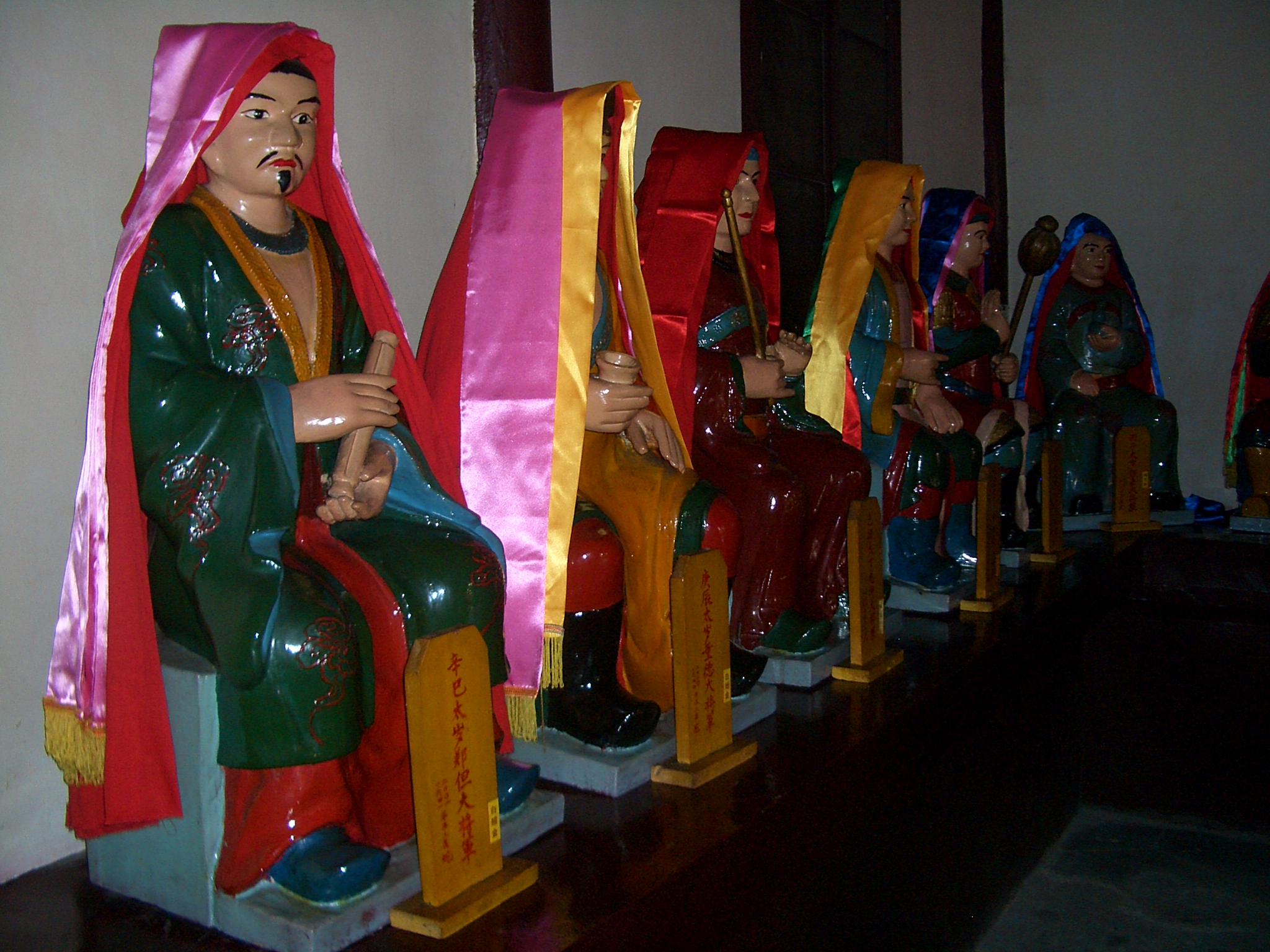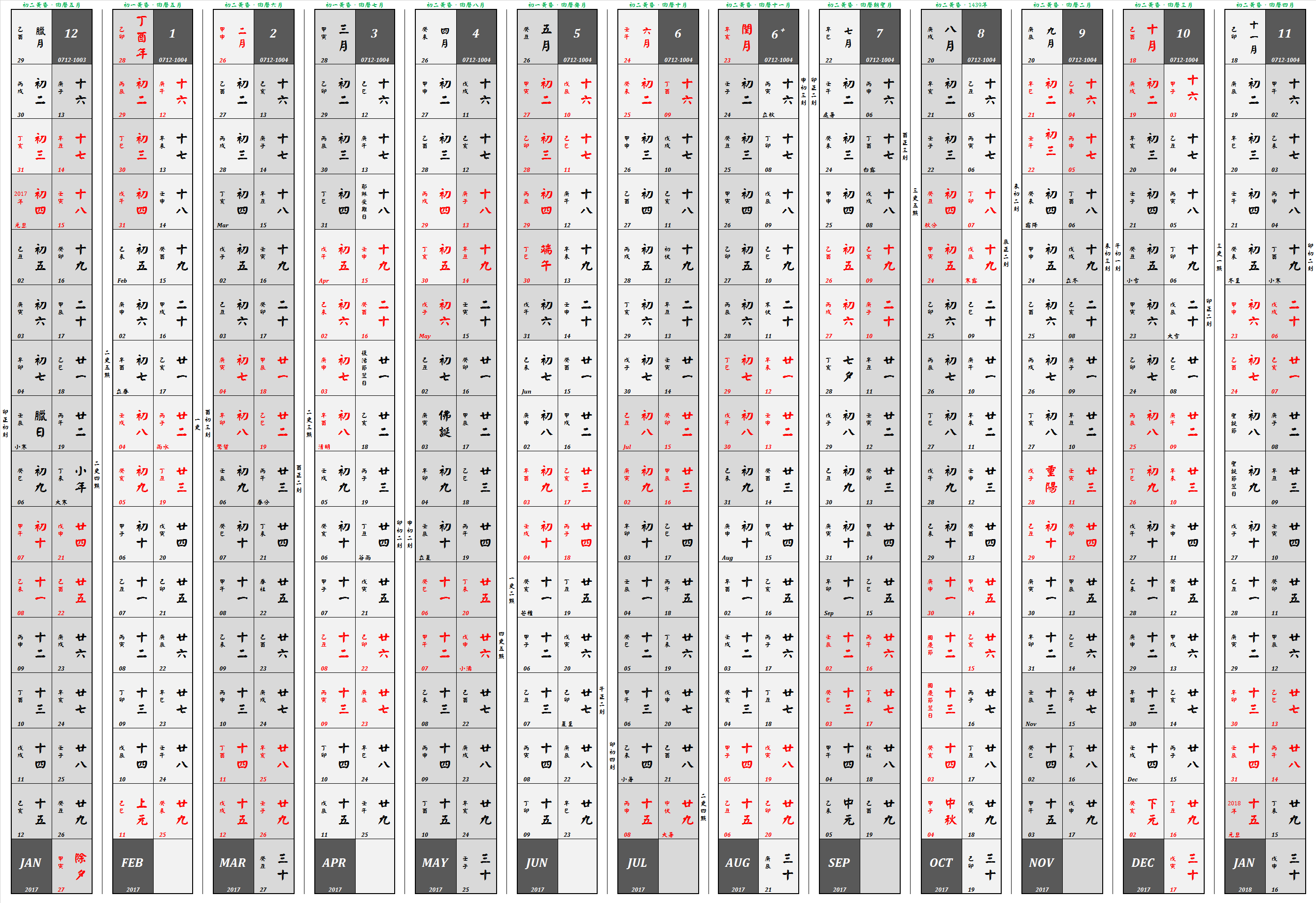|
Sexagenary Cycle
The sexagenary cycle, also known as the stems-and-branches or ganzhi ( zh, 干支, gānzhī), is a cycle of sixty terms, each corresponding to one year, thus a total of sixty years for one cycle, historically used for recording time in China and the rest of the East Asian cultural sphere and Southeast Asia. It appears as a means of recording days in the first Chinese written texts, the Shang dynasty, Shang oracle bones of the late second millennium BC. Its use to record years began around the middle of the 3rd century BC. The cycle and its variations have been an important part of the traditional calendrical systems in Chinese-influenced Asian states and territories, particularly those of Japanese calendar, Japan, Korean calendar, Korea, and Vietnamese calendar, Vietnam, with the old Chinese system still in use in Taiwanese calendar, Taiwan, and in Mainland China. In India, the Ahom people, Dai-Ahom (descendants of Dai people, Dai ethnic minority of Yunnan who migrated to Assam in ... [...More Info...] [...Related Items...] OR: [Wikipedia] [Google] [Baidu] |
East Asian Cultural Sphere
The East Asian cultural sphere, also known as the Sinosphere, the Sinic world, the Sinitic world, the Chinese cultural sphere, the Chinese character sphere encompasses multiple countries in East Asia and Southeast Asia that were historically influenced by Chinese culture. According to academic consensus, the East Asian cultural sphere is made up of four entities: Greater China, Japan, Korea, and Vietnam. Other definitions sometimes include Mongolia and Singapore, because of limited historical Chinese influences or increasing modern-day Chinese diaspora. The East Asian cultural sphere is not to be confused with the Sinophone world, which includes countries where the Chinese-speaking population is dominant. Imperial China was a regional power and exerted influence on tributary states and neighboring states, among which were Japan, Korea, and Vietnam. These interactions brought ideological and cultural influences rooted in Confucianism, Buddhism, and Taoism. During classical h ... [...More Info...] [...Related Items...] OR: [Wikipedia] [Google] [Baidu] |
Tet Offensive
The Tet Offensive was a major escalation and one of the largest military campaigns of the Vietnam War. It was launched on January 30, 1968 by forces of the Viet Cong (VC) and North Vietnamese People's Army of Vietnam (PAVN) against the forces of the South Vietnamese Army of the Republic of Vietnam (ARVN), the United States Armed Forces and their allies. It was a campaign of surprise attacks against military and civilian command and control centers throughout South Vietnam. The name is the truncated version of the Lunar New Year festival name in Vietnamese, Tết Nguyên Đán, with the offense chosen during a holiday period as most ARVN personnel were on leave. The purpose of the wide-scale offensive by the Hanoi Politburo was to trigger political instability, in a belief that mass armed assault on urban centers would trigger defections and rebellions. The offensive was launched prematurely in the late night hours of 30 January in the I and II Corps Tactical Zones of South V ... [...More Info...] [...Related Items...] OR: [Wikipedia] [Google] [Baidu] |
Akan Calendar
The Akan people (a Kwa group of West Africa) appear to have used a traditional system of timekeeping based on a six-day week (known as ''nnanson'' "seven-days" via inclusive counting). The Gregorian seven-day week is known as ''nnawɔtwe'' (eight-days). The combination of these two system resulted in periods of 42 days, known as ''adaduanan'' (meaning "forty days"). Nnanson The composition or construction of the Adaduanan cycle appears to be based on an older six-day week. The six-day week is referred to as ''Nnanson'' (literally seven-days) and reflects the lack of zero in the numbering systems; the last day and the first day are both included when counting the days of a week. Nnawɔtwe The seven-day week is referred to as ''Nnawɔtwe'' (literally eight days). Like ''Nnanson'' the last day and the first day are both included when counting the days of a week. Adaduanan When the six-day week is counted side-by-side with the seven-day week it takes a total of 42 day ... [...More Info...] [...Related Items...] OR: [Wikipedia] [Google] [Baidu] |
Yin And Yang
Yin and yang ( and ) is a Chinese philosophy, Chinese philosophical concept that describes opposite but interconnected forces. In Chinese cosmology, the universe creates itself out of a primary chaos of material energy, organized into the cycles of yin and yang and formed into objects and lives. Yin is the receptive and yang the active principle, seen in all forms of change and difference such as the annual cycle (winter and summer), the landscape (north-facing shade and south-facing brightness), sexual coupling (female and male), the formation of both men and women as characters and sociopolitical history (disorder and order). Taiji (philosophy), Taiji or Tai chi () is a Chinese cosmological term for the "Supreme Ultimate" state of undifferentiated absolute and infinite potential, the oneness before duality, from which yin and yang originate. It can be compared with the old ''Wuji (philosophy), wuji'' (, "without pole"). In the cosmology pertaining to yin and yang, the mate ... [...More Info...] [...Related Items...] OR: [Wikipedia] [Google] [Baidu] |
Least Common Multiple
In arithmetic and number theory, the least common multiple, lowest common multiple, or smallest common multiple of two integers ''a'' and ''b'', usually denoted by lcm(''a'', ''b''), is the smallest positive integer that is divisible by both ''a'' and ''b''. Since division of integers by zero is undefined, this definition has meaning only if ''a'' and ''b'' are both different from zero. However, some authors define lcm(''a'',0) as 0 for all ''a'', since 0 is the only common multiple of ''a'' and 0. The lcm is the "lowest common denominator" (lcd) that can be used before fractions can be added, subtracted or compared. The least common multiple of more than two integers ''a'', ''b'', ''c'', . . . , usually denoted by lcm(''a'', ''b'', ''c'', . . .), is also well defined: It is the smallest positive integer that is divisible by each of ''a'', ''b'', ''c'', . . . Overview A multiple of a number is the product of that number and an integer. For example, 10 is a ... [...More Info...] [...Related Items...] OR: [Wikipedia] [Google] [Baidu] |
Duodecennial
An anniversary is the date on which an event took place or an institution was founded in a previous year, and may also refer to the commemoration or celebration of that event. The word was first used for Catholicism, Catholic feasts to commemorate saints. Most countries celebrate national anniversaries, typically called national days. These could be the List of national independence days, date of independence of the nation or the adoption of a new constitution or form of government. There is no definite method for determining the date of establishment of an institution, and it is generally decided within the institution by Convention (norm), convention. The important dates in a sitting monarch's reign may also be commemorated, an event often referred to as a "jubilee". Names * Birthdays are the most common type of anniversary, on which someone's birthdate is commemorated each year. The actual celebration is sometimes moved for practical reasons, as in the case of an official ... [...More Info...] [...Related Items...] OR: [Wikipedia] [Google] [Baidu] |
Jupiter
Jupiter is the fifth planet from the Sun and the List of Solar System objects by size, largest in the Solar System. It is a gas giant with a mass more than two and a half times that of all the other planets in the Solar System combined, but slightly less than one-thousandth the mass of the Sun. Jupiter is the List of brightest natural objects in the sky, third brightest natural object in the Earth's night sky after the Moon and Venus, and it has been observed since Pre-history, prehistoric times. It was named after the Jupiter (mythology), Roman god Jupiter, the king of the gods. Jupiter is primarily composed of hydrogen, but helium constitutes one-quarter of its mass and one-tenth of its volume. It probably has a rocky core of heavier elements, but, like the other giant planets in the Solar System, it lacks a well-defined solid surface. The ongoing contraction of Jupiter's interior generates more heat than it receives from the Sun. Because of its rapid rotation, the planet' ... [...More Info...] [...Related Items...] OR: [Wikipedia] [Google] [Baidu] |
Earthly Branches
The twelve Earthly Branches or Terrestrial Branches are a Chinese ordering system used throughout East Asia in various contexts, including its ancient dating system, astrological traditions, zodiac and ordinals. Origin This system was built from observations of the orbit of Jupiter. Chinese astronomers divided the celestial circle into 12 sections to follow the orbit of ''Suìxīng'' (Jupiter, the Year Star). Astronomers rounded the orbit of Suixing to 12 years (from 11.86). Suixing was associated with ''Shètí'' (η Boötis) and sometimes called Sheti. Jonathan Smith has proposed that the first meanings of the earthly branches, predating the Shang dynasty, were phases of the moon, with the heavenly stems at that point referring to divisions of the ecliptic. After being adopted as a calendar these would have lost their clear lunar reference, permitting their repurposing for Jupiter stations. History In correlative thinking, the 12 years of the Jupiter cycle also identif ... [...More Info...] [...Related Items...] OR: [Wikipedia] [Google] [Baidu] |
Chinese Ten-day Week
The traditional Chinese calendar (also known as the Agricultural Calendar [農曆; 农历; ''Nónglì''; 'farming calendar'], Former Calendar [舊曆; 旧历; ''Jiùlì''], Traditional Calendar [老曆; 老历; ''Lǎolì'']), is a lunisolar calendar which identifies years, months, and days according to astronomical phenomena. In China, it is defined by the National Standards of the People's Republic of China, Chinese national standard GB/T 33661–2017, "Calculation and Promulgation of the Chinese Calendar", issued by the Standardization Administration of China on May 12, 2017. Although modern-day China uses the Gregorian calendar, the traditional Chinese calendar governs holidays, such as the Chinese New Year and Lantern Festival, in both China and overseas Chinese communities. It also provides the traditional Chinese nomenclature of dates within a year which people use to select auspicious days for Auspicious wedding dates, weddings, funerals, moving or starting a business. ... [...More Info...] [...Related Items...] OR: [Wikipedia] [Google] [Baidu] |
Heavenly Stems
The ten Heavenly Stems or Celestial Stems () are a Chinese system of ordinals that first appear during the Shang dynasty, c. 1250 BC, as the names of the ten days of the week. They were also used in Shang-period ritual as names for dead family members, who were offered sacrifices on the corresponding day of the Shang week. The Heavenly Stems were used in combination with the Earthly Branches, a similar cycle of twelve days, to produce a compound cycle of sixty days. Subsequently, the Heavenly Stems lost their original function as names for days of the week and dead kin, and acquired many other uses, the most prominent and long lasting of which was their use together with the Earthly Branches as a 60-year calendrical cycle. The system is used throughout East Asia. Table The Japanese names of the Heavenly Stems are based on their corresponding Wuxing elements (e.g. ''ki'' for "wood", ''mizu'' for "water"), followed by the possessive/attributive particle の (''no'') and the word ... [...More Info...] [...Related Items...] OR: [Wikipedia] [Google] [Baidu] |




